|
68. Danaus plexippus (Linnaeus, 1758) / Monarch / Nymphalidae – Danainae
NL: monarchvlinder / D: Monarch / F: le monarque
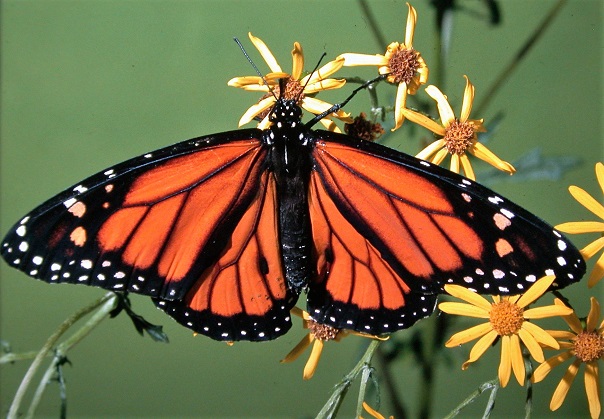 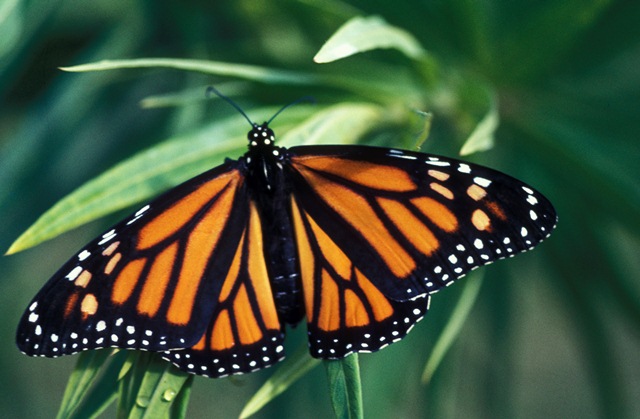 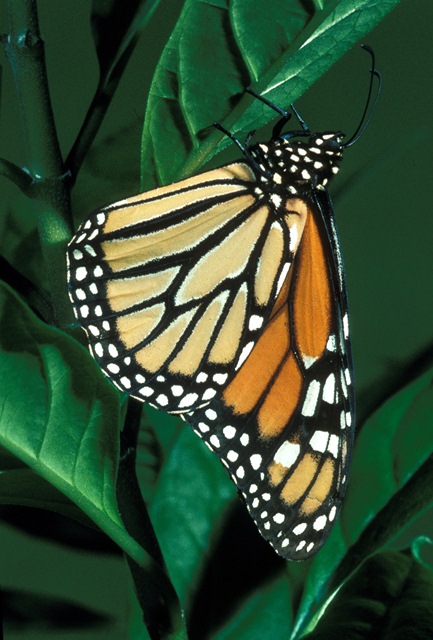
Photographs: Frits Bink, Frits Bink ©.
Very large, wing length 45 (43-50) mm. Occurs in the Benelux as a very rare stray. The monarch is the most strongly migratory butterfly in the world (Scott 1986: 229).
Strays are seen on the western coast of Ireland and England in late autumn (Asher et al. 2001:320-323). In the Benelux there are only a few sightings. However, the species is very popular to breed in butterfly houses and escapees may be seen sometimes in any location.
Butterflies are seen in England from end-September until mid-October. These sightings in the autumn are reported from regions of a temperate climate, amplitude 4 to 6 and heat sum 700°d to 1200°d. Recently there were non-migratory populations established in southern Europe; these had a continuous development in a subtropical maritime climate, amplitude 5 to 8, and heat sum 2900°d to 3900°d and a climate window the whole year open.
Danaus plexippus feeds on Asclepias species, an American plant genus of herbs containing a toxic milky juice. The species A. currasavica is an attractive plant with orange flowers and is for that reason already in the 18th century introduced in tropical countries as an ornamental plant for gardens and pots. Gomphocarpus fruticosus, another host-plant spread all over the tropics by agriculture activities. In the 19th century the butterfly had an enormous expansion, about 1870 it appeared in Australia, south-east Asia and Hawaii. About 1880 it was observed on the Canary Islands, in which the indigenous African species Danaus chrysippus occurs. It reached Europe (Malaga, Spain) in the 1980’s and fed on A. currasavica, which appeared as a weed along the irrigation canals.
In America the butterfly is well known for its southward winter migration from as far north as Canada to roosts in California (near Santa Cruz) and Mexico (Sierra Madres), a distance of some 3600 km (Urquart, 1960).
Ecological characteristics
Behaviour over time
Overwintering: adult, in America in enormous gatherings in roosting trees.
Reproduction: oviposition starts after 7-12 days when the body contains 80 (32-134) eggs, potential production 3.3 times as much. During migration and overwintering the development of eggs in the body stops.
Larval feeding periods: 2-3 weeks in summer.
Generations: 2-5 in North-America (Scott 1986: 229-231).
Spreading of risk: great by dispersing of eggs in time and space.
Life cycle: egg 4 (3-5) days; larva 18 (13-22) days; pupa 15 (12-18) days.
Life span of adult: in summer generation 6-7 weeks, in overwintering generation 35 weeks.
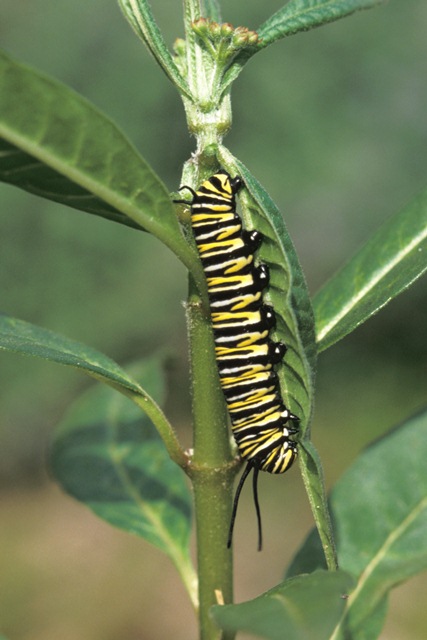 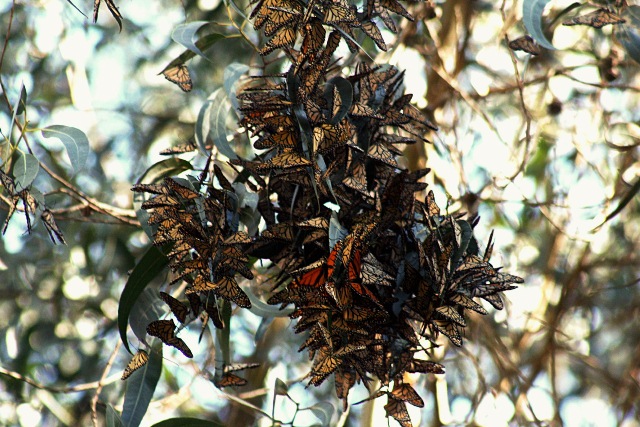
Photographs: Frits Bink, Wikipedia ©.
Behaviour in space
From stay-at-home to migrant: migrant that follows a seasonal pattern of a northwards migration in spring and southwards in autumn.
Finding a mate: male patrols and seduces the female by scent released from its abdominal hair pencils, a typical feature of the Danainae. Danaus plexippus performs this courtship weekly.
Orientation in the landscape: open landscape and edges, during migration also orientation on sun and probably on earth magnetism.
Oviposition: preferably near flower buds but also on young leaves.
Defence
Threats from other organisms: larva, pupa and adult are protected by the distasteful chemical of the host-plant.
Threats from the environment: heat, drought and stormy weather, although the butterfly can endure unfavourable conditions quite well.
Feeding habits
Adult: nectar, all kinds of big flowers.
Larva: as small larva it prefers flowers, young leafs and unripe seeds, fully grown larvae eats older leaves, having bitten the petiole to stem the flow of sap into the eaten areas.
Larval foodplants
Plant species: Asclepiadaceae, Asclepias curassavica, A. incarnata, A. speciose, A. syriaca, Gomphocarpus fruticosus.
Journal
Rearing experiment based on specimens obtained from Jan Meerman.
4 August 1988: freshly laid eggs and just hatched larvae received.
7 August: moulted L1-2, ambient temperature 21°C– 24°C.
9 August: moulted L2-3, ambient temperature 24°C– 26°C.
11 August: larvae in moult L3-4.
13 August: larvae in moult L4-5.
16 August: smallest larva in moult L4-5, biggest one fully grown.
18 August: three larvae pupated.
22 August: another two larvae pupated.
30 August: first adult appeared. 9 September: last pupa hatched.
Table 68-1. Results of dissections
Estimated egg production after count ova size 1.0 - 0.05 and after 1.0 up to 0.005.

Additional figures pupal weights:
22 May 1995: males 1352.8 ± 192 mg, (n=17), females 1293.7 ± 88 mg, (n=10)
10 July 1995: males 1422.1 ± 93.7 mg (n=14), females 1337.2 ± 96.1 mg (n=13)
Pupal weights of males being heavier than females is somewhat unusual but not unique in butterflies; for examples it is also found in Plebejus argus and Heteropterus morpheus, among others.
Table 68-2. Collection and observation localities
AUS, Gympie 26° 12’ 51”S – 152° 40’ 31”E; 13 March 1983 (all stages present, larvae on Gomphocarpus fruticosa).
E, Canary Islands, La Gomera, Valle Gran Rey 28° 05’N – 17° 20’W; 2 March 1993, 12 March 1993 (adults only).
E, Canary Islands, Tenerife, La Orotava 28° 22’N – 16° 32’W; 9 March 1995, 15 March 1995 (adults and larvae in botanical garden on Asclepias incarnata).
Fig. 68-1. Danaus plexippus, phenogram adapted from Asher et al. 2002: 322.
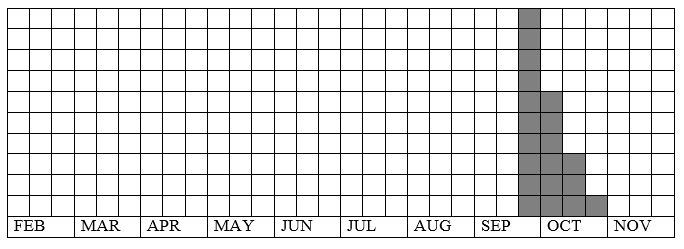
Fig. 68-2. Danaus plexippus, habitat characteristics in the region of natural occurence.
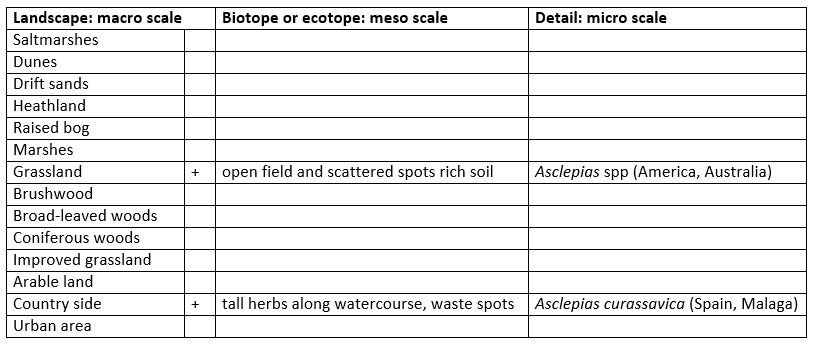
Fig. 68-3. Danaus plexippus, climate matrix, heat-sums 2600-3600°d, January +12ºC.
Light part: climate zone with immigrant in late summer; darker part: climate zone with continuous generations.
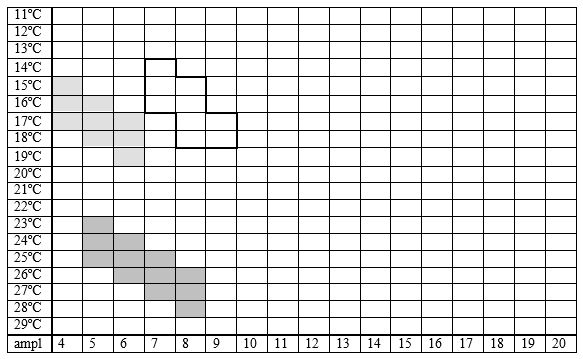
|










